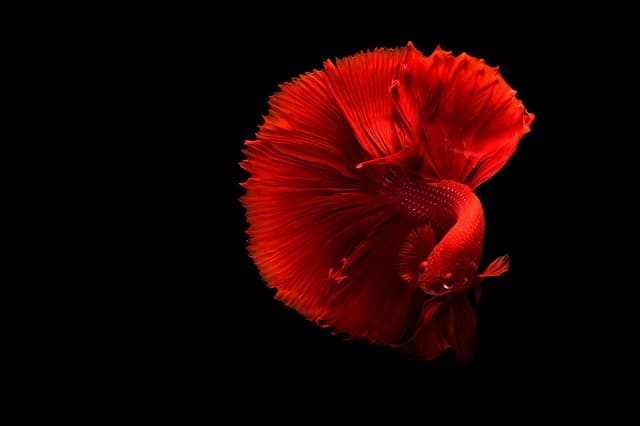Choosing to breed any species of fish in captivity can be both time consuming and expensive for an aquarium hobbyist. This includes the so-called undemanding and ‘hardy’ goldfish as well. If you have goldfish and are thinking of breeding them, you may be wondering how easy it is?
Breeding goldfish isn’t as easy as you may think. For reproduction to occur, you must: create a suitable aquatic environment; ensure you have healthy, fertile males and females; provide high quality food; provide the proper incubation for eggs; and provide a safe set-up for offspring.
Now that you know it may not be as simple as you thought to breed goldfish in confinement, let’s explore this topic together in more detail. We’ll learn what to do as aquarists to promote successful procreation as well as how to setup the breeding tank, what water conditions are required, what the male-to-female ratio should be, what food is best, and how to artificially inseminate fish.
So, if you’re ready to ‘dive deeper’ into the reproductive world of the goldfish, then let’s get to it!
What is Needed to Promote Goldfish Breeding?
Breeding goldfish in captivity isn’t impossible, but it does require certain standards to be successful. These include the following criteria:
Create a Stable, Suitable Aquatic Environment
An ideal tank environment is the first step to promoting goldfish breeding. The aquarium must contain at least 20-gallons of water. The temperature should be between 60- and 70-degrees F with a pH of 7.0 to 8.0. Stability is the key – abrupt changes in water parameters will discourage goldfish from spawning.
Ensure Healthy, Fertile Males and Females
Making sure you have both healthy and fertile specimens is necessary got goldfish breeding. If your fish are sick or stressed, they won’t procreate. Watch for signs of spawning – males display white bumps on their bodies and females will appear rounder than usual.
Provide Nutrient-Rich, High Quality Food
Offering protein-rich, high-quality food is an important part of goldfish breeding. Instead of the typical pellet or flaked edibles, provide them with meaty options such as frozen brine shrimp and/or live blackworms up to 3 times a day.
Create the Proper Incubation Conditions for Eggs
Ensuring the right conditions for eggs to hatch is vital to goldfish breeding. You must separate the eggs from the adults as they’re likely to be eaten. A warm, stable aquatic environment should encourage eggs to hatch within 5 days.

Provide a Safe Environment for Offspring to Mature
Providing a clean, safe space for offspring to grow is critical to goldfish breeding. Keeping fry in the same tank they were bred in and moving the parents is best. Making sure the water parameters are balanced and offering micro worms and/or mosquito wrigglers twice a day is recommended.
How to Breed Goldfish in Captivity?
To successfully breed goldfish in captivity, you should follow the 10 steps listed below:
- Setup your breeding tank in advance – ensure the water parameters are conducive to the species of goldfish you intend to keep and hook-up a heater, filter, and light.
- Add plants to mimic their natural habitat and include a few spawning mops to help safeguard the eggs.
- Purchase your goldfish at least a year prior to breeding – purchase your goldfish in the summer as this species likes to breed in the springtime.
- Make sure to buy at least 5 fish (3 males and 2 females) – males are smaller and thinner whereas females are larger and rounder.
- Feed your goldfish a meaty diet of brine shrimp and black worms – be sure not to overfeed as excess food will sink to the bottom and rot, negatively affect the water parameters.
- Raise the temperature in the breeding tank by 2-degrees F to replicate springtime water temperatures and stimulate goldfish to begin breeding – leave the light on longer as well.
- Do partial water changes every week to help cycle the tank – remove 15% of the existing liquid and replace it with new, conditioned water.
- Watch for signs of spawning – once the eggs have been laid, remove the adults and place them in a pond or large planted aquarium with the ideal water parameters for that species.
- Observe the tank closely for the first few days and watch for signs of hatching.
- Feed hatchlings micro worms and mosquito wrigglers – once fry have reached a length of 3 inches, move them back into the parent tank.
Suggestion: before offering micro worms/mosquito wrigglers, you can feed baby goldfish egg yolks. Begin by hard boiling an egg. Next, break off a pea-sized piece of yolk and put in a jar with water. Then, shake-up the jar to create a cloudy mixture. Finally, add the mixture (in small amounts) to the breeding tank at feeding time. Store the remaining mixture in the fridge and discard (if not used) after 3 days.
What are the Ways to Make Breeding Goldfish Easier?
If you’ve tried everything and you just can’t get your goldfish to breed, then perhaps you need to weigh the following options:
Species-only Tank
A species-only tank may be a way to get non-reproductive goldfish to start breeding. In a community environment with multiple species of fish, you boost the chances of stress from bullying and increase the number of potential diseases. Both anxiety and illness will prevent goldfish from procreating.
Artificial Insemination
If your goldfish are having trouble breeding naturally, you can try artificial insemination. The steps to doing this properly and safely include the following:
- Introduce one male and one female to the breeding tank.
- Pick up the male with your hand and gently rubbing his vent to release the sperm.
- Swirl the sperm around in the breeding the tank water.
- Take hold of the female and gently rub her vent to release the eggs.
- Swirl the eggs in the water to combine the sperm and the eggs.
Note: goldfish can bruise easily so you must be extra careful and extremely gentle when attempting to clear their vents. You can lift the fish out of the water for a few minutes to clear the vents if it’s easier for you but doing so underwater is preferable.
More Males than Females
To better then chances of your goldfish reproducing in captivity, try introducing more males than females to the breeding tank. Studies have shown that a ratio of 3 males to 1 female greatly improves the likelihood of successful procreation.

What are the Easiest Fish to Breed in Captivity?
Livebearers such as guppies, platies, and mollies are typically easier to breed than egg-layers like goldfish. The reason being that live-bearing offspring emerge larger and more fully developed than those of egg-layers. As well, live-bearing fish are more mobile and better able to care for themselves. Eggs are also easier to eat, making them the preferred target of other fish, including their parents!
Final Thoughts
To sum things up, breeding goldfish requires a stable, suitable aquatic environment; healthy and fertile specimens; high-quality, protein-rich food; the right incubation conditions for eggs to hatch; and a safe space for offspring to mature. The keys to spawning success from an aquarist’s standpoint are patience and attention to detail.
I trust this article has been of help to you. Thanks for reading and good luck with your aquarium hobby.
Recommended Posts
What to do if Your Goldfish Looks Fat?
What Kind of Water do Goldfish Need?
Why Do Goldfish Eat Their Own Poop?
How to Stop Tropical Fish from Breeding






